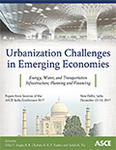ASCE India Conference 2017
Modeling Urban Land Use Dynamics through Markov Model Using Geospatial Tools for Kota, India
Publication: Urbanization Challenges in Emerging Economies: Energy and Water Infrastructure; Transportation Infrastructure; and Planning and Financing
ABSTRACT
Urban land use dynamics is an important component for land use management and regional planning of the area. In this paper an attempt is made to analyze the processes of spatial and temporal change pattern in Kota City of Rajasthan, which is undergoing a fast but unplanned development. Satellite-derived urban land use maps of 1999, 2011, and 2016 and Markov model coupled with geospatial technology have been adopted to predict the spatial distribution of land use change in future. Transition among different land use types is analyzed to understand the spatial as well as temporal variability during a period of 1999-2016. Markov model performance was evaluated between the empirical urban land use map extracted from Landsat 8 (multispectral merged panchromatic) image and the simulated land use map obtained from the Markov model. Later spatial pattern changing characteristics were investigated by predicting the land use/cover changes up to 2030. Result implies the rising trend in built-up areas especially in periphery of the city with decreasing trend in agriculture land. This study suggests that this spatio-temporal model provides not only a quantitative description of changes in the past but also the estimated direction and magnitude of likely changes in the future. Hence, if the current trends exist without sustainable development measures, severe land degradation will occur that could indirectly affect the local environment of the city. Therefore, this study is helpful for local authorities to understand the complex land use system and develop guidelines as well as policies for sustainable urban expansion and ecological conservation.
Get full access to this chapter
View all available purchase options and get full access to this chapter.
ACKNOWLEDGEMENT
Authors acknowledge Department of Science & Technology, Government of India for financial support vide reference number SR/WOS-A/ET-1047/2014 (G) under Women Scientist Scheme (WOA-A) to carry out this research work.
REFERENCES
Barros, J. X. (2004). “Urban growth in Latin American cities: exploring urban dynamics through agent-based simulation” (Doctoral), University of London.
Bathrellos, G. D., Gaki-Papanastassiou, K., Skilodimou, H. D., Papanastassiou, D., Chousianitis, K. G. (2012). “Potential suitability for urban planning and industry development using natural hazard maps and geological-geomorphological parameters”. Environ Earth Sci 66(2), 537-548.
Dadhich, A. P., Goyal, R., Dadhich, P. N. (2017). “An assessment of urban space expansion and its impact on air quality using geospatial approach”. J Urban Environ Engg, 11(1), 79-87.
Dadhich, A. P., Nadaoka, K. (2013). “Modeling Hydrologic response to land use change in Watersheds of Viti Levu Island, Fiji”. J Environ Res Dev 8(3), 492-503.
Dadhich, A. P., Nadaoka, K., Yamamoto, T., Kayanne, H. (2012). “Detecting coral bleaching using multispectral and panchromatic-fused multispectral Quickbird data and 2D thermal model in Ishigaki fringing reef area, Japan”. Coral reefs, 31(2), 425-439.
Dadhich, P. N., Hanaoka, S. (2010). “Remote sensing, GIS and Markov’s method for land use change detection and prediction of Jaipur district”. J Geomatics. 4, 9-15.
Dadhich, P. N., Hanaoka, S. (2011). “Spatio-temporal urban growth modeling of Jaipur, India”. J Urban Tech, 18(3), 45-65.
Dadhich, P. N., Hanaoka, S. (2016). “Remote Sensing Application in Monitoring Impact of Mining Activities on Urban Growth. The Case of Makrana Marble Mines, India”. J Settlements Spatial Planning, 7(2), 179-185.
Dongjie, G., Weijun, G., Kazuyuki, W., Hidetoshi, F. (2008). “Land use change of Kitakyushu based on landscape ecology and Markov model”. J Geogr Sci. 18, 455-468.
Eastman, J. R. (2012). IDRISI Selva; Clark Labs, Clark University: Worcester, MA, USA. Available online: http://uhulag.mendelu.cz/files/pagesdata/eng/gis/idrisi_selva_tutorial.pdf
Geertman, S., Stillwell, J. (2004). “Planning support systems: an inventory of current practice”. Comput Environ Urban 28, 291-310.
Kumar, S., Radhakrishnan, N., Mathew, S. (2014). “Land use change modelling using a Markov model and remote sensing, Geomatics”. Natural Hazards and Risk, 5(2), 145-156.
Masek, J. G., Lindsay, F. E and Goward, S. N. (2000). “Dynamics of urban growth in the Washington DC metropolitan area, 1973-1996, from Landsat observations”. International J Remote Sens, 21(18), 3473-3486.
Pradhan, B. (2011). “Use of GIS based fuzzy relations and its cross application to produce landslide susceptibility maps in three test areas in Malaysia”. Environ Earth Sci 63(2), 329-349.
Roy, H. G., Dennis, M. F., Emsellem, K. (2014). “Predicting land cover change in a Mediterranean catchment at different time scales”. In Computational Science and Its Applications—ICCSA 2014, Springer International Publishing: Basel, Switzerland, pp. 315-330.
Tewolde, M. G., Cabral, P. (2011). “Urban sprawl analysis and modelling in Asmara, Eritrea”. Remote Sens. 3, 2148-2165.
UN-HABITAT (2012). United Nations Human Settlements Programme. State of the World’s Cities Report 2012/2013: Prosperity of Cities; UN-HABITAT: Nairobi, Kenya, 2012.
United Nations. (2015). World Urbanization Prospects: The 2014 Revision; Population Division, Department of Economic and Social Affairs, United Nations: New York, NY.
Wu, N., Silva, E. A. (2009). “Integration of genetic agents and cellular automata for dynamic urban growth modeling”. Online at: http://www.geocomputation.org/2009/PDF/Wu_and_Silva.pdf
Yin, D., Chen, X., Yan, L., Huang, Z. (2007). “The research and realization of the land-use change forecasting model in development zones based on RS and GIS”. IEEE Proc, IGARSS. 3429-3432.
Zhang, R., Tang, C., Ma, S., Yuan, H., Gao, L., Fan, W. (2011). “Using Markov chains to analyze changes in wetland trends in arid Yinchuan plain, China”. Math Comput Modell. 54, 924-930.
Information & Authors
Information
Published In
Urbanization Challenges in Emerging Economies: Energy and Water Infrastructure; Transportation Infrastructure; and Planning and Financing
Pages: 472 - 480
Editors: Udai P. Singh, B. R. Chahar, Indian Institute of Technology, H. R. P. Yadav, Institution of Engineers (India), and Satish K. Vij
ISBN (Online): 978-0-7844-8202-5
Copyright
© 2018 American Society of Civil Engineers.
History
Published online: Dec 13, 2018
Authors
Metrics & Citations
Metrics
Citations
Download citation
If you have the appropriate software installed, you can download article citation data to the citation manager of your choice. Simply select your manager software from the list below and click Download.
